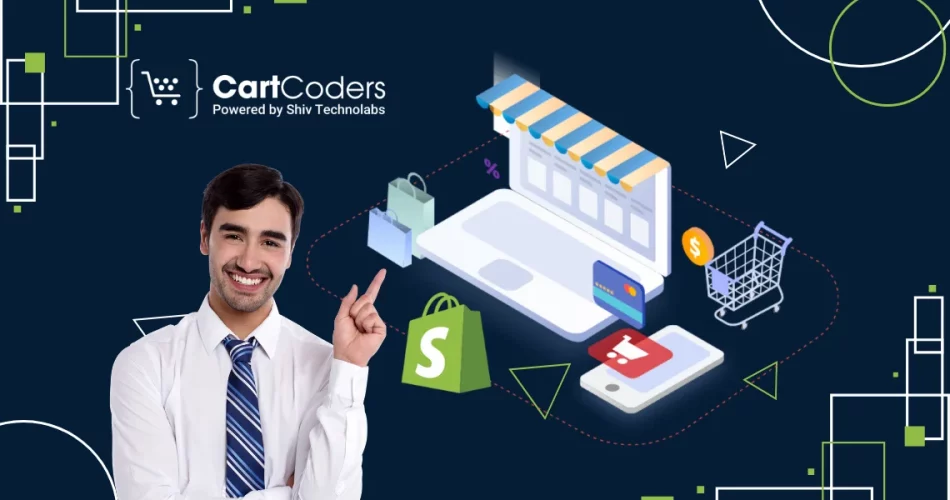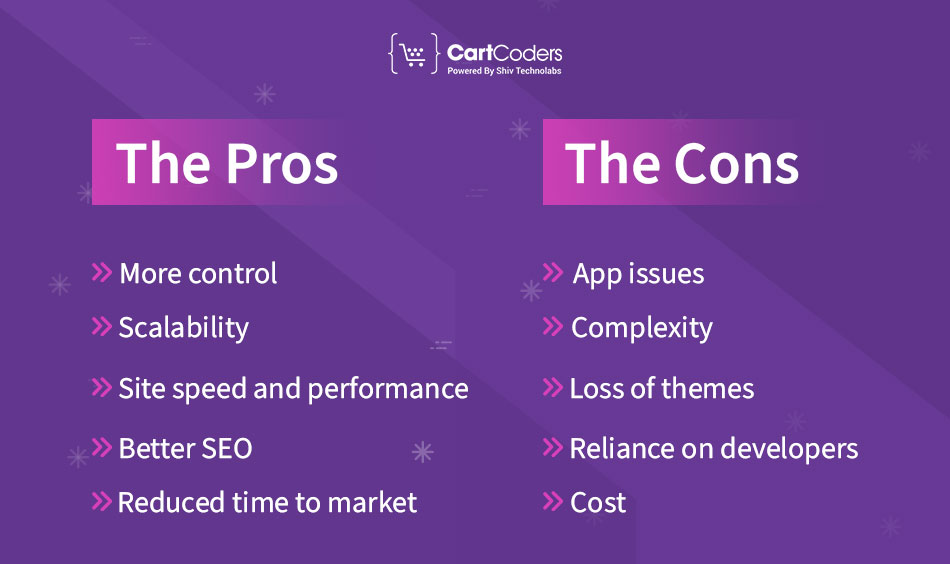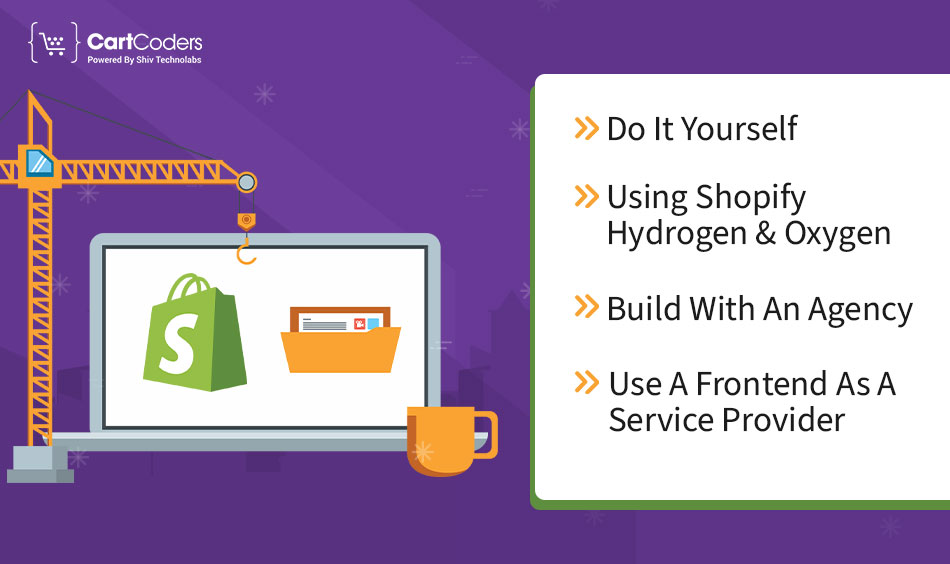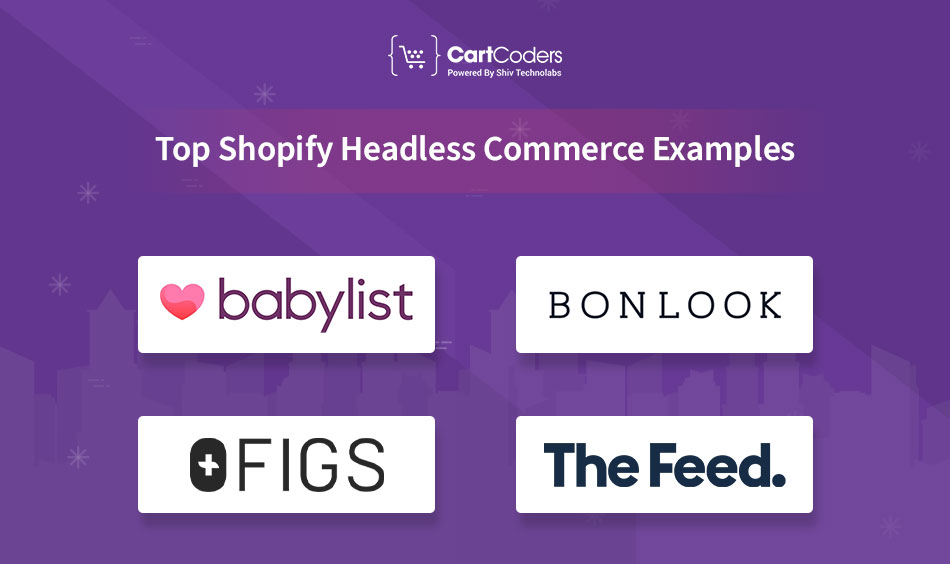Custom Engagement Solutions
Unlock tailored solutions with a free, no-obligation strategy session.
Expert Developers & Engineers on Demand
Scale Your Team with Skilled IT Professionals
Expert Guidance for Digital Transformation

Shopify Headless Commerce is a growing preference for brands as the world of eCommerce evolves. And when we consider the merging of important eCommerce trends, it makes sense. Business owners cannot ignore that between 2021 and 2025, the size of eCommerce industry may reach $11 trillion.
In order to capture buyers’ attention, convert them into customers and maintain those relationships, businesses must create innovative multichannel experiences.
This is where headless commerce comes into play. By enabling developer experiences, Headless ensures that you can create amazing purchasing experiences for your customers. You can sell anywhere because there are no design or development limits. Your store is the whole world.
But what about Shopify Headless Commerce? How are brands going headless with their existing Shopify storefronts? Is it practical? Find out the answer below!

Headless commerce is an eCommerce system where the frontend and backend of your store are separate. In this context, the front end is called “head”. In this sense, “headless” means a commerce store with a separate frontend and backend.
Shopify is a great one-stop shop for all your eCommerce needs. However, you might find some features or design capabilities a little too rigid as you scale up.
While this one-size-fits-all approach can work for a while, as your company grows, you may find that you need more than what Shopify Storefront offers. If your brand wants to grow, it will need a storefront that evolves with it.
The good news is you don’t have to completely redesign it or build another eCommerce platform from scratch. In fact, Shopify was built with decoupling in mind and Shopify Headless Commerce allows a frontend that meets your evolving business requirements easily as you grow. This is where their storefront API comes into play.
The key to headless commerce is the API or application program interface. The frontend and backend are connected by an API, which enables information to be sent between the two in real time.
Furthermore, depending on your needs, you can use various backend systems with headless storefronts. For example, a Content management system (CMS), Progressive web app (PWA), Customer relationship management (CRM), or Digital experience platform (DXP) might be some of these systems.
One of them includes Shopify Plus launched by Shopify in 2014 which is always up to date with the most advanced technologies used for providing customizable enterprise solutions for businesses and has headless architecture too.
When you go headless with Shopify, all the backend services offered by Shopify remain intact. But still, you get full control over what appears on your Shopify store front end.
It’s a way to overcome limitations imposed by default Shopify like strict URL syntax and offers countless possibilities for customization and personalization, unlike its alternative solutions.
Also, Shopify has decided to build Shopify headless hydrogen in recognition of the fact that headless commerce can have a huge impact on the business of eCommerce merchants. In particular, the React-based framework will help Shopify’s merchants and developers build custom storefronts with top-personalized experiences for shoppers.
As a result, Shopify Headless Commerce and Shopify headless hydrogen are going to disrupt the e-commerce industry. This allows sellers to have better control over the front-end performance by using a backend optimized for Shopify e-commerce components.
The best option for small businesses is to have the Shopify backend and frontend connected. This way, it is cheaper and easier than going headless, and you still get all the features needed to run a successful store.

However, if you want more advanced customization options and scalability then choosing headless Shopify might be the right thing to do.
We’re going to look at some of the key pros and cons of using Shopify’s headless commerce.

If you’ve decided that your Shopify store’s frontend needs a makeover, there are three primary ways to do this, each with its own pros and cons. What strategy you go with will depend on your business requirements:
On a framework, you can build a Shopify Headless Commerce Store manually. Actually, if you use Shopify Plus to build your headless architecture, it will give you full control over the e-commerce functionality. This may provide more flexibility for you. It means that you don’t have to fit into someone else’s system since you can take charge of the development and coding.
But it needs skilled knowledge. That is to say, using traditional architectures also takes a lot more thinking, experience, and preparation into account. Most especially, there is a need for extensive back-end and client-side knowledge about Shopify headless API.
A team that knows frameworks like React.js and Ember should be used when creating a storefront through the Shopify headless storefront API as liquid cannot be used with this approach if you want to design your own unique store front accessible via the Shopify Headless Storefront API. They need frameworks such as Next.js or Gatsby if they are building static sites. Overall, it’s difficult for merchants because it requires so much time and effort on their part.
At their Unite 2021 conference, Shopify announced that React frontends could be built by developers with React server components of their own. This approach renders React Server Components on the server to improve the performance of React apps. These “commerce” components consist of key parts of Shopify stores such as cart and product order form.
Shopify headless hydrogen frontends can be hosted on Shopify servers using Oxygen, a V8 worker runtime. It doesn’t need dev ops and has a very fast loading speed. It’s better than the first option, but it hasn’t been tested widely enough.
Luckily, if you suspect that the former two choices demand expertise in the field, this one can overcome all these disadvantages.
You’ll work with a knowledgeable partner for headless sites. Suppose you choose a Shopify Headless Commerce agency correctly. In that case, the person you’ll be working with knows how to design headless sites that interface with Shopify’s backend and is well aware of all potential dangers – and how to prevent them!
Furthermore, an agency can assist you in becoming headless by going bespoke or cooperating with a frontend-as-a-service vendor to complete your project. Not yet, an agency will be able to assist you and advise you during the design stage, as well as the knowledge to convert your bright new concept into a reality. They will also be able to recommend which features, layout and navigation work best with a Shopify backend thereby optimizing your site.
Isn’t it great? In the event you respect, contact Cartcoders today for in-depth advice. Cartcoders is a leading Shopify development agency with more than nine years of experience. Precisely speaking, this company can assist you in creating a user-friendly and powerful Shopify Headless Commerce store. It is evident from the fact that Cartcoders has worked together with numerous traders and has done over 200+ projects successfully.
It’s okay if you don’t feel like researching, designing, building, testing and deploying a bunch of platforms and custom APIs. And you’ll get a complete package that allows you to set up your store without any extra hard work on your part. This is where the front-end providers come in.
In fact, there are many amazing new products that make it easier to create best-practice Shopify Headless Commerce websites. Some PWA-builders apps are an example of this; they come with ready-made connections to popular e-commerce systems like Shopify and services such as search engines, reviews sections or merchandising tools. It even comes with a lightweight CMS and a visual composer.
Also, using an experience platform doesn’t mean you can’t also work with an agency on rebuilding your website. For instance, Cartcoders also deals on website builders which means not only will you have experienced help in running your store smoothly but a whole new site will also be available for you to operate in the future.
In addition, you will find other partners including Pagefly, Secomapp, growave, Langify among others that bring in a holistic tech stack aiming to propel the world of e-commerce.
Nonetheless, this approach may result in relinquishing direct control over certain deeper internal constituents of your technology stack. Instead of being able to dive into scripts and make some changes whenever you feel like it; you will have to ask your front-end provider for some technical background enhancements.

Shopify headless is growing in popularity to the point where there are simply too many headless Shopify examples to list, so here are a few.
Babylist is a website where expecting parents can share their wishlists with gift givers. Every product on the list is sourced from third-party sources so users may compare, browse product recommendations and select the best options for purchasing.
A single website that can do everything. It shows how hard it would be to build this site using a monolithic eCommerce platform. So Babylist chose Shopify headless with numerous platforms included to ensure seamless web performance. They include CMS (Contentful), order management system (Shopify), checkout system (Shopify Plus).
Since using Headless method, Babylist has seen 145% YoY growth in order volumes up from 300% monthly iOS app checkouts after the first month. And 102% more gifts through web-based platform.
Not only is going headless a sophisticated solution for eCommerce companies, but it also benefits omnichannel stores.
BonLook is a Canadian company that sells customized lenses and prescription eyeglasses online and in 37 physical stores across Canada.
Bonlook must have prescriptions uploaded as well as select options for lens material, frame style, size, and glass design when selling prescription eyeglasses online. When customers purchase through either the website or any of their branches, Bonlook can seamlessly operate its omnichannel resulting to an 18% increase in average order value.
Another Shopify firm leveraging the headless approach is FIGS, a healthcare apparel and lifestyle brand. The backend functions are managed by the store using Shopify Plus. However, since their web presence demands more personalization they had to use Unbounce together with Next.js on their frontend.
Moreover, using this Shopify Headless Commerce method allows them to connect each custom-built landing page with one product page on Shopify hence greatly improving customer’s online shopping experience in FIGS. Furthermore, all data will be sent back into Shopify Plus thus allowing FIGS to process orders within minutes while adjusting stock levels accordingly.
At the first glance, The Feed was skeptical if going headless with their Shopify site would actually yield speed and UX benefits, so they decided to test it out. They made two identical versions of their website, one headless and another one using Shopify Liquid, to compare them. To their surprise, the headless version performed better: it had 5.24% more conversions and earned 10.28% more income per visitor.
Going headless has its costs and effort implications. Depending on the usefulness, additional tools, and level of customization, the Shopify headless pricing could range from $50,000 to $500,000; this is in addition to annual maintenance charges.
You can have other channels built on a headless platform at prices as low as $99 per month if you build your bespoke storefront with an app. These channels could be audio streams or video game integrations.
On that note, Shopify Headless Commerce pricing varies according to how intricate your project is. Building and implementation are just two of them. Don’t forget fees paid to third party vendors or recurring charges for subscriptions to a headless CMS platform.
Shopify Headless Commerce is not necessary when creating your store. Nonetheless, headless Shopify seems to be a web development technique that many companies will adopt soon, considering all the long-term advantages it can offer such as ultimate customizability and flexibility. If your Shopify business is growing, going headless with your store may be an excellent way to improve site performance.
Being a growing brand using Shopify and you want more flexibility, going headless does not necessarily mean a huge development burden. If you would like to keep up with the latest technological trends and have a store with Shopify Headless Commerce, contact Cartcoders. Our Cartcoders Shopify headless services have an in-built drag-and-drop page builder tool which helps you simplify the process of designing your storefront and create professional store presences that convert well.
Headless Commerce means separating the front end of an e-commerce website from its back end. For Shopify, this involves decoupling the presentation layer (storefront) from the commerce engine. Unlike traditional commerce where the front end and back end are tightly coupled, with Headless Commerce there is more flexibility and customization. While using Shopify’s powerful back-end to manage products, orders, etc., merchants can choose different front-end technologies or frameworks or even go channel-agnostic.
Headless Commerce can greatly enhance performance for an ecommerce website on Shopify. Pages load faster when front-end is decoupled because only necessary information is transmitted. This means a better user experience which may have positive impact on conversion rates.
Despite various advantages provided by Headless Commerce, there are still obstacles that need to be taken into account. One such obstacle could be managing multiple frontend channels leading towards inconsistent user experiences being faced by merchants. There might also be increased complexity with managing multiple skills in both front-end and back-end technologies.
Projects delivered in 15+ industries.
95% retention rate, building lasting partnerships.
Serving clients across 25+ countries.
60+ pros | 10+ years of experience.